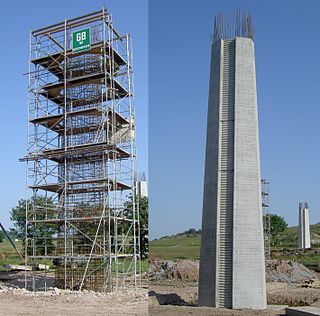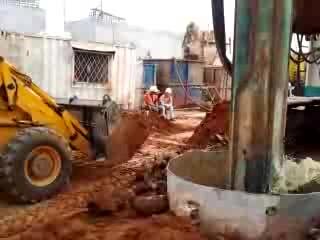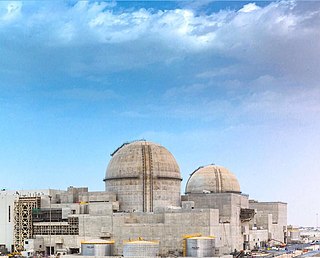This article needs additional citations for verification .(March 2021) (Learn how and when to remove this template message) |
Steel plate construction is a method of rapidly constructing heavy reinforced concrete items.
This article needs additional citations for verification .(March 2021) (Learn how and when to remove this template message) |
Steel plate construction is a method of rapidly constructing heavy reinforced concrete items.
The method was developed in Korea in 2004 at a steel fabricator.[ citation needed ]
Each assembly has two parallel steel plates joined by welded stringers or tie bars. The assemblies are then moved to the job site and placed with a crane. Finally, the space between the plate walls is filled with concrete. [1] The method provides excellent strength because the steel is on the outside, where tensile forces are often greatest.
Construction with this method is accomplished roughly twice as fast with as other methods of reinforced concrete construction, because by constructing at specialized off-site fabrication facilities it avoids tying rebar and constructing forms on-site. [2] Because of the rapid construction time, the cost of large-scale projects can be significantly decreased when this method is used.
The method is of special interest for rapidly constructing nuclear power plants, which use large reinforced concrete structures, and typically have long construction times, with high costs. [3]

Reinforced concrete (RC), also called reinforced cement concrete (RCC), is a composite material in which concrete's relatively low tensile strength and ductility are compensated for by the inclusion of reinforcement having higher tensile strength or ductility. The reinforcement is usually, though not necessarily, steel bars (rebar) and is usually embedded passively in the concrete before the concrete sets.

The RBMK is a class of graphite-moderated nuclear power reactor designed and built by the Soviet Union. The name refers to its unusual design where, instead of a large steel pressure vessel surrounding the entire core, the core is surrounded by a cylindrical annular steel tank inside a concrete vault and each fuel assembly is enclosed in an individual 8 cm diameter pipe surrounded in graphite which allows the flow of cooling water around the fuel.

Dry cask storage is a method of storing high-level radioactive waste, such as spent nuclear fuel that has already been cooled in the spent fuel pool for at least one year and often as much as ten years. Casks are typically steel cylinders that are either welded or bolted closed. The fuel rods inside are surrounded by inert gas. Ideally, the steel cylinder provides leak-tight containment of the spent fuel. Each cylinder is surrounded by additional steel, concrete, or other material to provide radiation shielding to workers and members of the public.

The Nyongbyon Nuclear Scientific Research Center is North Korea's major nuclear facility, operating its first nuclear reactors. It is located in Nyongbyon County in North Pyongan Province, about 100 km north of Pyongyang. The center produced the fissile material for North Korea's six nuclear weapon tests from 2006 to 2017, and since 2009 is developing indigenous light water reactor nuclear power station technology.

The Virgil C. Summer Nuclear Power Station occupies a site near Jenkinsville, South Carolina, in Fairfield County, South Carolina, approximately 20 miles (32 km) northwest of Columbia.

A containment building, in its most common usage, is a reinforced steel, concrete or lead structure enclosing a nuclear reactor. It is designed, in any emergency, to contain the escape of radioactive steam or gas to a maximum pressure in the range of 275 to 550 kPa. The containment is the fourth and final barrier to radioactive release, the first being the fuel ceramic itself, the second being the metal fuel cladding tubes, the third being the reactor vessel and coolant system.

The AP1000 is a nuclear power plant designed and sold by Westinghouse Electric Company. The plant is a pressurized water reactor with improved use of passive nuclear safety and many design features intended to lower its capital cost and improve its economics.
Structural steel is a category of steel used for making construction materials in a variety of shapes. Many structural steel shapes take the form of an elongated beam having a profile of a specific cross section. Structural steel shapes, sizes, chemical composition, mechanical properties such as strengths, storage practices, etc., are regulated by standards in most industrialized countries.

The New Safe Confinement is a structure built to confine the remains of the number 4 reactor unit at the Chernobyl Nuclear Power Plant, in Ukraine, which was destroyed during the Chernobyl disaster in 1986. The structure also encloses the temporary Shelter Structure (sarcophagus) that was built around the reactor immediately after the disaster. The New Safe Confinement is designed to prevent the release of radioactive contaminants, protect the reactor from external influence, facilitate the disassembly and decommissioning of the reactor, and prevent water intrusion.
The Karachi Nuclear Power Plant is a large commercial nuclear power plant located at the Paradise Point in Karachi, Sindh, Pakistan. Officially known as Karachi Nuclear Power Complex, the power generation site is composed of three commercial nuclear power plants with two plants under construction with the financing and investment provided by China and the International Atomic Energy Agency (IAEA).

Leningrad Nuclear Power Plant is a nuclear power plant located in the town of Sosnovy Bor in Russia's Leningrad Oblast, on the southern shore of the Gulf of Finland, some 70 kilometres (43 mi) to the west of the city centre of Saint Petersburg.

A deep foundation is a type of foundation that transfers building loads to the earth farther down from the surface than a shallow foundation does to a subsurface layer or a range of depths. A pile or piling is a vertical structural element of a deep foundation, driven or drilled deep into the ground at the building site.

Carolinas–Virginia Tube Reactor (CVTR), also known as Parr Nuclear Station, was an experimental pressurized tube heavy water nuclear power reactor at Parr, South Carolina in Fairfield County. It was built and operated by the Carolinas Virginia Nuclear Power Associates. CVTR was a small test reactor, capable of generating 17 megawatts of electricity. It was officially commissioned in December 1963 and left service in January 1967.

The Onagawa Nuclear Power Plant is a nuclear power plant located on a 1,730,000 m2 site in Onagawa in the Oshika District and Ishinomaki city, Miyagi Prefecture, Japan. It is managed by the Tohoku Electric Power Company. It was the most quickly constructed nuclear power plant in the world.

Iran's nuclear program is made up of a number of nuclear facilities, including nuclear reactors and various nuclear fuel cycle facilities.

The Astravets Nuclear Power Plant is a nuclear power plant in Astravyets District, Grodno Region, Belarus. Initial plans of the plant were announced in the 1980s, but were suspended after the 1986 Chernobyl disaster. The drive for revival of the project was fueled by the Russia-Belarus energy dispute in 2007. The plant consists of two nuclear reactors built between 2016 and 2020, and probably two more reactors by 2025. The reactors were supplied by Atomstroyexport.
The Fuqing Nuclear Power Plant is a nuclear power plant in Fuqing, Fujian Province, China. The plant is located on the coast of Xinghua Bay, near Qianxue Village, Sanshan Town. The station has four 1,089 megawatt (MW) CPR-1000 pressurized water reactors (PWRs). The CPR-1000 is an advanced PWR design developed by China from the Areva-designed PWRs at the Daya Bay Nuclear Power Plant. The plant was jointly constructed and is operated by China National Nuclear Corporation (51%), China Huadian Corp. (39%) and the Fujian Investment & Development Co Ltd. (10%).
A core shroud is a stainless steel cylinder surrounding a nuclear reactor core whose main function is to direct the cooling water flow. The nuclear reactor core is where the nuclear reactions take place. Because the reactions are exothermic, cool water is needed to prevent the reactor core from melting down. The core shroud helps by directing this cool water towards the reactor core, providing stability to the nuclear reactions.

The Barakah nuclear power plant is the United Arab Emirates's first nuclear power station, the first nuclear power station in the Arabian Peninsula, and the first commercial nuclear power station in the Arab World. It consists of four APR-1400 nuclear reactors. Total capacity is 5,600 MW which is intended to supply up to 25% of UAE's energy needs. The site is in the Gharbiya region of Abu Dhabi, on the coastline between the Persian Gulf and the E11 highway, 50 km west of Ruwais.

The IPHWR-700 is an Indian pressurized heavy-water reactor designed by the Bhabha Atomic Research Centre. It is a Generation III+ reactor developed from earlier CANDU based 220 MW and 540 MW designs. It can generate 700 MW of electricity. Currently there are 6 units under construction and 10 more units planned, at a cost of INR 1.05 trillion.